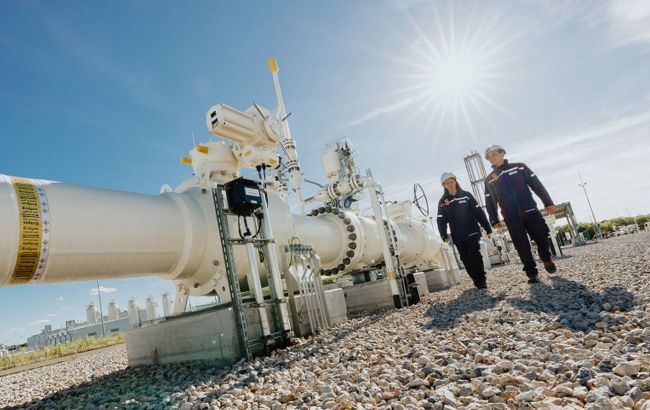'End of era': Why Russia cuts off gas to Austria and its impact on transit through Ukraine
 Photo: Austrian company OMV has stopped receiving gas directly from Russia (gasconnect.at)
Photo: Austrian company OMV has stopped receiving gas directly from Russia (gasconnect.at)
Russia's gas monopolist, Gazprom, recently stopped supplying natural gas to Austria via Ukraine – a route that had been in operation for decades.
Why Moscow cut off one of its key European customers and what this means for gas transit through Ukraine, read in the material by RBC-Ukraine.
Contents
- Why did Gazprom stop supplying Austria?
- Did Russia's decision impact gas transit through Ukraine?
- What will happen to gas transit through Ukraine?
Why did Gazprom stop supplying Austria?
News about possibly canceling Russian gas supplies to Austria broke out last week. The Austrian OMV (the largest oil and gas company in Central Europe), which sued Gazprom for 230 million euros, announced that it did not expect payments and, therefore, intended to offset this amount within the framework of the current contract, delaying payments for gas.
"Gazprom is aware of our actions. We are prepared for all eventualities," stated OMV CEO Alfred Stern.
The announcement caused European gas prices to rise by nearly 4%, reflecting supply risks and heightened concerns as the heating season begins.
Austria has depended on Russian gas to power its industries and heat homes for over half a century, maintaining one of the closest European ties to Moscow's energy sector. In 2018, Vienna extended its long-term contract with Gazprom until 2040. Since 2022, most of the region has been cut off from Russian gas due to Moscow's aggression in Ukraine. However, Hungary, Slovakia, and, until recently, Austria remained the largest importers.
Officially, gas supplies to Austria stopped on Saturday morning, November 16. The day before, Chancellor Karl Nehammer held a press conference to assure the availability of reliable alternative sources.
"We will not allow anyone to blackmail us. Not even the Russian president. We will not allow Putin's government, Putin himself, to bring us to our knees," he said.
According to OMV, domestic gas reserves are sufficient, with more than 90% full storage facilities. This will satisfy all customers' demands after the supplies from the Russian side have stopped.
Ursula von der Leyen, Head of the European Commission, emphasized that Putin is once again using gas as a weapon and blackmail. However, gas storage facilities are full across the European Union, and European countries are prepared for the coming winter. "Europe is united in support of Austria," she said.
Russian gas has traditionally been delivered to Austria via the Urengoy-Pomary-Uzhhorod pipeline passing through Ukraine. However, this route could soon be shut down, as Kyiv has revealed its intention not to renew the transit contract with Gazprom.
Ukraine's Deputy Minister of Foreign Affairs, Andrii Sybiha, condemned Moscow's actions. "The era of Europe's reliance on Russian gas is over. It is time to fully cut Russia's energy revenues and halt the financing of its war effort," he wrote on the social media platform X.
Did Russia's decision impact gas transit through Ukraine?
The cessation of direct Russian gas supplies to Austria is likely to have a limited impact on the European market, at least for now. At the same time, Russian gas continues to flow through Ukraine without interruption.
Gazprom declined to comment on the suspension of supplies to Austria but confirmed that Saturday's shipment request stood at 42.4 million cubic meters, consistent with daily averages in previous months. The request for Sunday was 42 million cubic meters.
According to Slovak operator Eustream, gas deliveries from Ukraine to Slovakia were proceeding as usual. Ukraine's Gas Transmission System (GTS) operator also reported no disruptions, confirming transit volumes of approximately 42 million cubic meters daily.
Reports indicate that, following OMV's suspension, other buyers have stepped in to purchase Russian gas. This does not mean that Russian fuel is not supplied to Austria at all.
"It can be sold by anyone who, unlike OMV, still receives gas from Gazprom under long-term contracts. In turn, it can be bought by anyone, including OMV," says Katja Yafimava, Senior Research Fellow at the Oxford Institute for Energy Studies.
According to Bloomberg, the Slovak company Slovensky Plynarensky Priemysel AS is receiving gas under contract, while Hungarian MVM Zrt. declined to comment. Austrian regulator E-Control's representative, Leo Lehr, confirmed that Russian gas is still entering Austria. "Russian gas will continue to flow to Austria without an import ban, such is the market dynamics," he noted.
Most likely, European companies from landlocked countries are taking the Austrian volume. For example, Czechia. In the summer of 2023, it reduced imports to almost zero and declared complete independence from Russian gas. Now, as data shows, Czechia is again receiving at least some of its Russian fuel via Slovakia.
Some Central European traders continue to purchase cheaper Russian gas, partly because transit costs for alternative routes, such as through Germany, are higher.
"Russian gas is reaching Czechia simply because it is economically viable," noted Dominik Rusinko, an analyst at Czech KBC Groep NV
Although Czechia has no direct contractual obligations with Gazprom, imports from Slovakia have risen significantly over the past year. Data from pipeline operator Net4Gas shows that Russian gas accounted for nearly half of Czechia's total imports last winter and approximately 74% in the fourth quarter of 2024.
What will happen to gas transit through Ukraine?
The volume of Russian gas supplies to Europe via Ukraine is relatively small. Last year, it amounted to about 15 billion cubic meters, which is only 8% of peak flows across all routes in 2018-2019.
Russia spent several decades building its share of the European gas market, which peaked at 35%. However, following the full-scale invasion of Ukraine in 2022, the European Union drastically reduced its reliance on Russian gas. This market share has been redistributed among Norway, the United States, and Qatar.
Gas is transported through Ukraine via the Urengoy-Pomary-Uzhhorod pipeline. The entry point into the Ukrainian system is at Sudzha (Kursk region), which is currently under the control of the Armed Forces of Ukraine.
About 3 billion cubic meters of gas are supplied to Slovakia, two-thirds to Hungary, and the rest to Austria (until recently). Alternative routes, such as Yamal-Europe through Belarus and Nord Stream via the Baltic Sea, are shut down. The only other active routes are the Blue Stream and Turkish Stream pipelines through the Black Sea. Turkey re-exports some of this gas to Europe, including Hungary.
Why does the Ukrainian route still operate? Despite relatively low transit volumes, the issue remains a dilemma for the European Union. This is partly due to the positions of Slovakia and Hungary, which have close ties with Moscow and challenge the EU's unified stance. Both countries claim that Russian gas is the cheapest option and accuse neighboring EU countries of high transit fees for alternative supplies.
Ukraine earns about $1 billion annually from the transit of Russian gas. According to Reuters calculations, Russia makes over $3 billion in profit from gas sales via Ukraine. While Russia appears interested in extending the contract, Kyiv has repeatedly stated that no direct agreement will be made, aiming instead to deprive Moscow of funding for its war effort. The current contract expires on December 31, 2024.
Without the Ukrainian route, Gazprom can supply gas via the Turkish Stream to Bulgaria, Serbia, or Hungary. However, this pipeline's capacity is limited.
In mid-October, the EU discussed two options to maintain transit through Ukraine, both involving Azerbaijan. The first one is to replace Russia with Azerbaijan as the supplier. However, given Azerbaijan's limited export capacity, this would require an exchange with Russia, making such a deal politically controversial. The second one is that Azerbaijan's SOCAR could take over Gazprom's role by selling gas to Europe or organizing transit through Ukraine. At that time, discussions on Azerbaijani gas were more consultations than negotiations. According to our sources, no concrete proposals had been made, and the issue was raised only at the consultation level.
Read the detailed information in the material "Transit rejection: Ukraine proposes new gas supply scheme to Europe".
At the end of October, Bloomberg reported that companies in Hungary and Slovakia were close to signing a contract for the supply of 12-14 billion cubic meters per year from Azerbaijan. However, Slovak company SPP denied that such a deal was imminent. Two sources in SOCAR stated that Bloomberg's report was inaccurate.
Sources: Publications by Reuters, Bloomberg, statements by OMV CEO Alfred Stern, European Commission President Ursula von der Leyen, information from Gazprom, and the Ukrainian Gas Transmission System (GTS) Operator.

